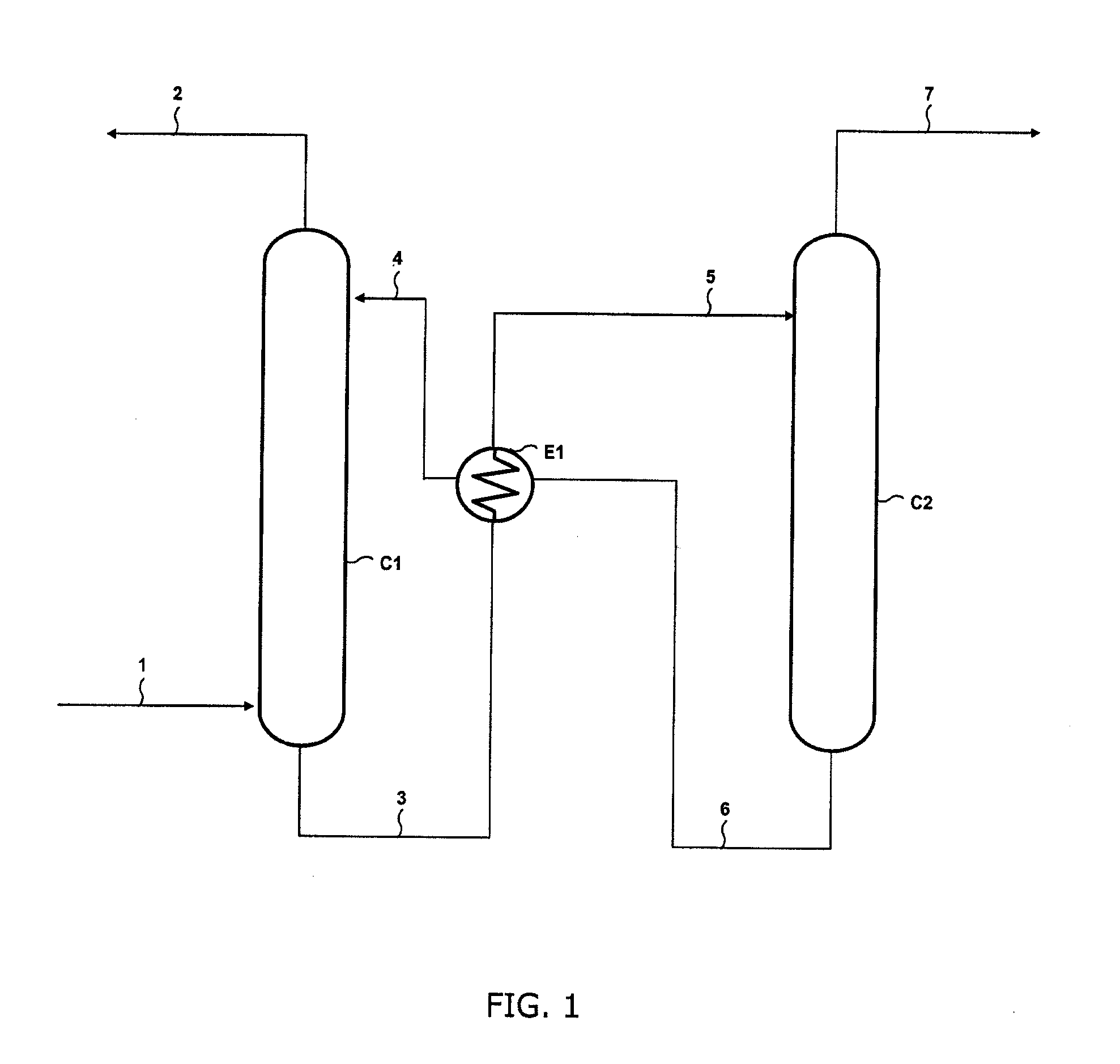Method of removing acid compounds from a gaseous effluent with an absorbent solution based on i/ii/iii triamines
a gaseous effluent and absorbent solution technology, which is applied in the direction of gaseous fuels, separation processes, fuels, etc., can solve the problems of attenuating performance, accelerating corrosion of plants, and limiting the kinetics of cosub>2 /sub>or cos capture, etc., to achieve greater density of amine sites and high cyclic capacity
- Summary
- Abstract
- Description
- Claims
- Application Information
AI Technical Summary
Benefits of technology
Problems solved by technology
Method used
Image
Examples
example 1
Operating Procedure for the Synthesis of Amines of General Formula (I)
[0149]For information, the following examples illustrate the synthesis of some molecules of the invention, it being understood that all the synthesis possibilities for these molecules, regarding the synthesis paths considered as well as the possible operating modes, are not described here.
N,N-diethyl-N′-[2-ethyl-N″-morpholino]-1,3-propanediamine
[0150]537 g (4.13 moles) 3-diethylaminopropylamine and 153.9 g (0.83 mole) 4-(2-chloroethyl)morpholine in chlorhydrate form are fed into a drum. The medium is brought to a temperature of 80° C. for 5 hours, then, after returning to ambient temperature, the medium is neutralized with 69.5 g soda pellets for 1 hour at 80° C. After filtering, the solid is washed with ether, then the ethereal fraction is added to the product and distillation of the medium is performed. 153.5 g of a fraction distilling around 127° C. in 1.5 mm Hg, whose purity determined by gas chromatography is...
example 2
Capture Capacity of Amines of General Formula (I) Containing a Tertiary Nitrogen Taken in a Ring
[0157]An absorption test is carried out on aqueous amine solutions in a perfectly stirred closed reactor whose temperature is controlled by a regulation system. For each solution, absorption is conducted in a 50-cm3 liquid volume by injections of pure CO2 from a reserve. The solvent solution is first evacuated prior to any CO2 injection. The pressure of the gas phase in the reactor is then monitored as a function of time after the CO2 injections. A global material balance on the gas phase allows to measure the solvent feed ratio α=nb moles of acid gas / nb moles of amine.
[0158]By way of example, the feed ratios (α=nb moles of acid gas / nb moles of amine) obtained at 40° C. for different CO2 partial pressures can be compared between N,N-diethyl-N′-[2-ethyl-N″-morpholino]-1,3-propanediamine, N,N-diethyl-N′-[2-ethyl-N″-pyrolidino]-1,3-propanediamine and N,N-diethyl-N′-[2-ethyl-N″-piperidinyl]-1...
example 3
Capture Capacity of Amines of General Formula (I) Whose Secondary Nitrogen is Hindered in α
[0164]The measurements and calculations carried out for Example 2 are repeated.
[0165]By way of example, the feed ratios (α=n acid gas / n amine) obtained at 40° C. for different CO2 partial pressures can be compared between N,N-dimethyl-N′-[1(dimethylamino)-2-propyl]-1,2-ethanediamine, N,N-diethyl-N′-[1(dimethylamino)-2-propyl]-1,2-ethanediamine, N,N-diethyl-N′-[1(dimethylamino)-2-propyl]-1,3-propane-diamine, N,N-diethyl-N′-[1(dimethylaminoethyl]-1,4-pentane diamine absorbent solutions according to the invention and a 30 wt. % MonoEthanolAmine absorbent solution for a post-combustion CO2 capture application, as well as a 40 wt. % MethylDiethanolAmine absorbent solution for natural gas treatment applications, more particularly decarbonation applications for meeting the liquefied natural gas specifications.
Case relative to post-combustion CO2 captureConcen-TPPCO2 =Generic nametration(° C.)0.1 barN...
PUM
| Property | Measurement | Unit |
|---|---|---|
| temperature | aaaaa | aaaaa |
| temperature | aaaaa | aaaaa |
| pressure | aaaaa | aaaaa |
Abstract
Description
Claims
Application Information
 Login to View More
Login to View More - R&D
- Intellectual Property
- Life Sciences
- Materials
- Tech Scout
- Unparalleled Data Quality
- Higher Quality Content
- 60% Fewer Hallucinations
Browse by: Latest US Patents, China's latest patents, Technical Efficacy Thesaurus, Application Domain, Technology Topic, Popular Technical Reports.
© 2025 PatSnap. All rights reserved.Legal|Privacy policy|Modern Slavery Act Transparency Statement|Sitemap|About US| Contact US: help@patsnap.com



